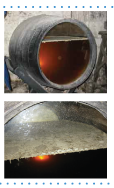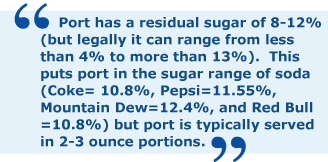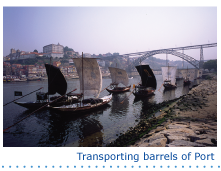|

...Continued from previous page
Before bottling, the Sherry can be sweetened, color added, and/or alcohol added depending on the style desired. Pedro Ximenez grapes are used in creating sweetening agents and Moscatel adds the coloring. Vino de Color is Moscatel grape juice reduced to 1/3 to 1⁄2 its original volume. This is typically used to make East Indian and Brown Sherries. Vino Dulce is raisinated Pedro Ximenez or Palomino grapes. Dulce Apadago is unfermented grape must with grape spirits added or sweet wine with fermentation arrested by adding grape spirits. Dulce Alimbar is a sweet mixture of half glucose and half fructose.
View Charts on Fortified Wine Production >
PORT
“Sip your spirits and cure your cold,but I will take Port that will cure all things, even a bad character. For there was never a port drinker who lacked friends to speak for him” –William Thackery
Port was created because the English hated the French. At times, French wine was prohibited to be imported into England, and at other times high punitive taxes were levied on French goods. While the English had long been a fan of the great wines of Bordeaux (it was the closest wine region to England and easiest to ship), they explored other options to get their wine fix on. The deep, rich, tannic wines of Portugal’s Douro were discovered. To ensure safe travel on the ship back to England brandy was added to stabilize and protect the wine.
Port comes from the Oporto region in Northern Portugal in the Douro Valley (its name meaning ‘River of Gold’). Within the Douro Valley there are three sub regions: Baixo Corgo, Cima Corgo, and Duoro Superior. The soil here is comprised of schist, granite, sand, clay, and quartz. A vineyard ranking system has been established to identify the best land. Created by the Cadastro, this system evaluates soil composition, production/yields, slope, stoniness, locality, altitude, shelter, sun exposure/aspect, grape varieties, training method, age of vines, and density. Scored on each category the highest score possible is 2,031 points- but any property with over 1,200 points gets an A rating. To receive an F, or failing grade, a vineyard must score fewer than 200 points. The Instituto do Vinho do Porto (IVP) controls overall Port production, can inspect a port house anytime, and calculates how much Port can be produced each vintage. The production permitted is based on the Cadastro rankings and point system. Poor F ranked vineyards rarely get to make any Port- but no real loss as w ho wants to drink a failing Port? The Casa do Douro is the governing body that represents growers and the Commissao Interprofessional da Regiao Demarcada do Douro (CIRDD) represents both growers and shippers. Port is traditionally made in Douro in Northern Portugal and shipped down the Douro River to Villa Nova de Gaia. Along with Istanbul, Villa Nova de Gaia is the most humid city in Europe. High humidity supports the aging process with low evaporation. While Port no longer has to be aged in Villa Nova de Gaia, it usually still is. When aged in the hot Duoro, ho wants to drink a failing Port? The Casa do Douro is the governing body that represents growers and the Commissao Interprofessional da Regiao Demarcada do Douro (CIRDD) represents both growers and shippers. Port is traditionally made in Douro in Northern Portugal and shipped down the Douro River to Villa Nova de Gaia. Along with Istanbul, Villa Nova de Gaia is the most humid city in Europe. High humidity supports the aging process with low evaporation. While Port no longer has to be aged in Villa Nova de Gaia, it usually still is. When aged in the hot Duoro,  there is a noticeable caramelization of flavors commonly referred to as Douro Bake. there is a noticeable caramelization of flavors commonly referred to as Douro Bake.
The Duoro is one on the oldest delimited wine regions, being demarcated as an official production zone in 1756. While there are 80 grape varieties allowed in Port, only eight are recommended:
Red varietals: Touriga Nacional, Touriga Franca, Tinta Barroca, Tinta Roriz (also known as Tempranillo), and Tinta Cao
White varietals: Gouveio (also known as Verdelho), Malvasia Fina, and Viosinho
LET'S MAKE SOME PORT!
To make Port the fermentation is arrested by adding grape spirits, which stops the fermentation (conversion of sugars to alcohol) that results in a sweet wine. The shorter fermentation time could mean less color and tannin extraction. To concentrate the pigment and tannins an aggressive pressing and maceration take place. The grapes were traditionally pressed by vineyard workers feet (feet are strong enough to crush the skin and pulp while keeping the bitter pip intact) in large shallow lagares. Wild yeasts begin the fermentation, fermentation gets hotter, and more pigment and tannins are extracted. After 24-36 hours, the fermenting  grape juice is about half converted to wine, initial sugar measurement of 12-13 Baume has been half converted to alcohol leaving 6-8 Baume. grape juice is about half converted to wine, initial sugar measurement of 12-13 Baume has been half converted to alcohol leaving 6-8 Baume.
The juice/wine is transferred from the large square lagares where it is pressed into giant vats. A neutral grape spirit, Aguardente, is added that is about 77% alcohol by volume. Geropiga, or extra sweet Port, can be added to the blend to increase sugar if necessary. Once the alcohol is added, it reaches 18-20% ABV and all ambient yeasts are killed. The alcohol level is too high for yeasts to live and continue converting sugar to alcohol so the fermentation process is completed. The resulting Port has a residual sugar of 8-12% (but legally it can range from less than 4% to more than 13%). This puts port in the sugar range of soda (Coke= 10.8%, Pepsi=11.55%, Mountain Dew=12.4%, and Red Bull =10.8%), but port is typically served in 2-3 ounce portions.
Sidenote: The high sugar content of Port wine does not make it ideal for volume consumption. If you ever find yourself in Portugal drinking Port all night chances are high you will wake up with a serious hangover!
There are several types of Port and they fall into two catergories:
Bottle Aged - Vintage and Single Quinta Ports- the reductive aging process means the wine will deteriorate faster once the bottle is opened.
Barrel Aged - all other Ports - the oxidative aging process means the wine will hold flavor for longer periods once the bottle is opened. (Small barrel aging is used to make Tawny Port in a controlled oxidative process. Large barrel aging is used to make Ruby Port to retain its color.)
|
